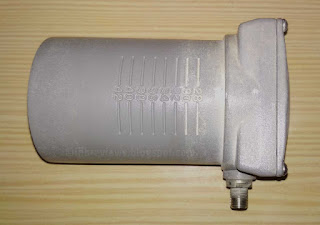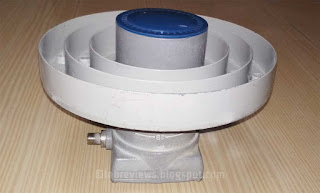A C-Band LNB or LNBF works much the same way as a Ku-Band LNB. However, a C-Band LNB is much bigger (about 3x the size) than an equivalent Ku-Band LNB. This is because C-Band uses a much lower frequency range: 3700-4200Mhz for standard C-Band or 3400-4200Mhz for the extended C-Band. Another difference is that, since the C-Band frequency range is much narrower than the Ku-Band, C-Band LNB's only use one local oscillator instead of two.
 |
| Zinwell D21A LNBF sideview. Note the F/D markings. |
The sticker on the back reveals the main specs: 3.4-4.2 Ghz (extended C-Band), 15ºK noise and 67 dB gain.
 |
| Zinwell D21A C-Band LNBF: 15ºK Noise, 67dB gain. |
Like most C-Band LNBF, the Zinwell D21A is sold with a prime focus scalar ring and a depolarizer plate for circular polarity signals.
 |
| Most C-Band LNBF's come with Prime-focus scalar ring and depolarizer plate. |
The LNB waveguide (body) as markings and slides along the scalar ring to adjust for different dish F/D ratios.
 |
| Zinwell D21A with attached prime-focus scalar ring. |
If the LNB is to be installed in an offset dish, a conical scalar feed horn should be used instead for adequate dish illumination.
 |
| With offset dishes a conical feed should be used for best performance. |
The Zinwell D21A can receive linear (Vertical/Horizontal) polarity or circular polarity (Left Hand/Right Hand) signals. To receive circular polarity signals a depolarizer is inserted on the waveguide in front of the receiving probes. The depolarizer is made of Teflon or fibreglass and it is usually provided when you buy the LNB.
 |
| To receive circular polarity signals a depolarizer plate is inserted in the waveguide. |
Opening the Zinwell D21A reveals the electronics. The local oscillator is under the metal casing and the adjustment screw indicates it is of the traditional DRO type. Some more recent mass market C-Band LNB designs using a PLL type oscillator are becoming commonly available. To learn about DRO and PLL oscillators please read this article. First stage amplification is done by NE3210S1 (K marking) super low noise HJ FET transistors.
 |
| Zinwell D21A LNB pcb |
Performance
The Zinwell D21A Dual Polarity LNBF is a good performer. Very weak low symbol rate signals can take some time to lock, but this is normal. This LNB is marked as having 15ºK noise temperature, but it probably has around 20ºK true noise. There are C-Band LNB's marked as having noise temperatures as low as 12ºK, but this unlikely to be true and just marketing tricks.

No comments:
Post a Comment